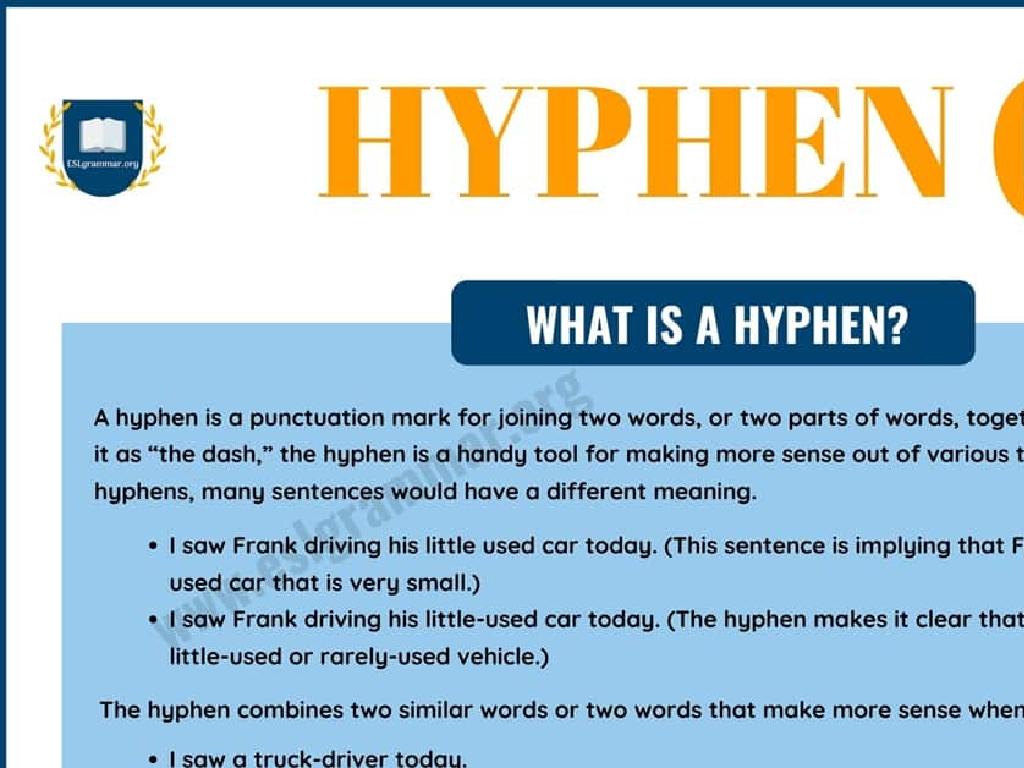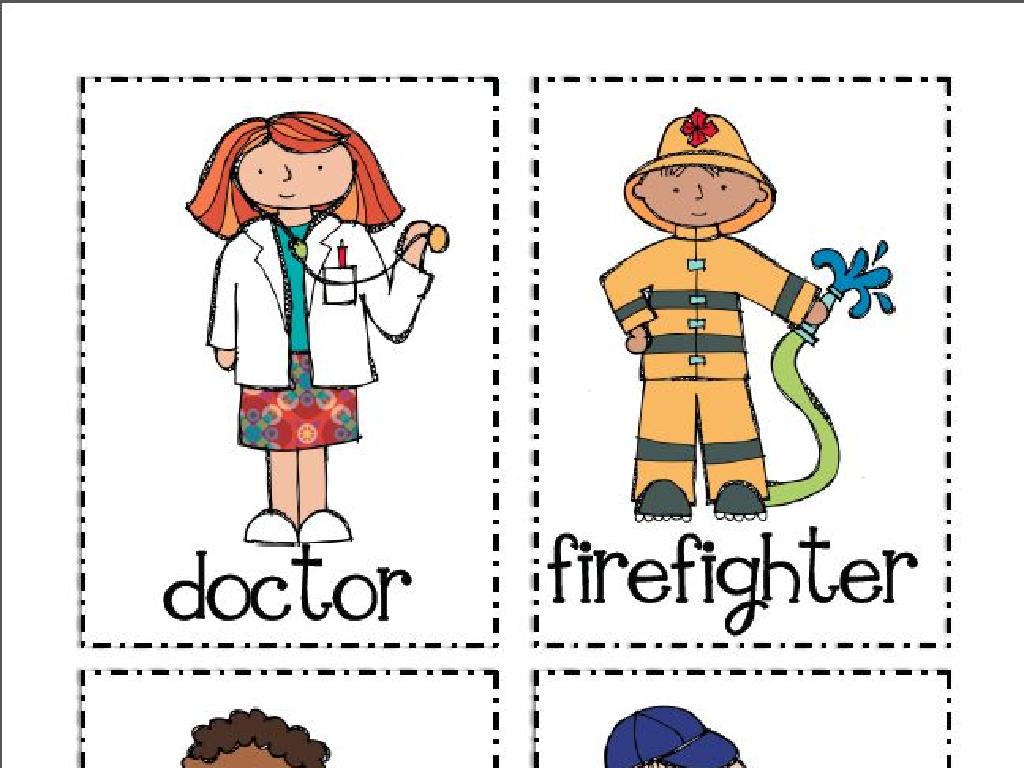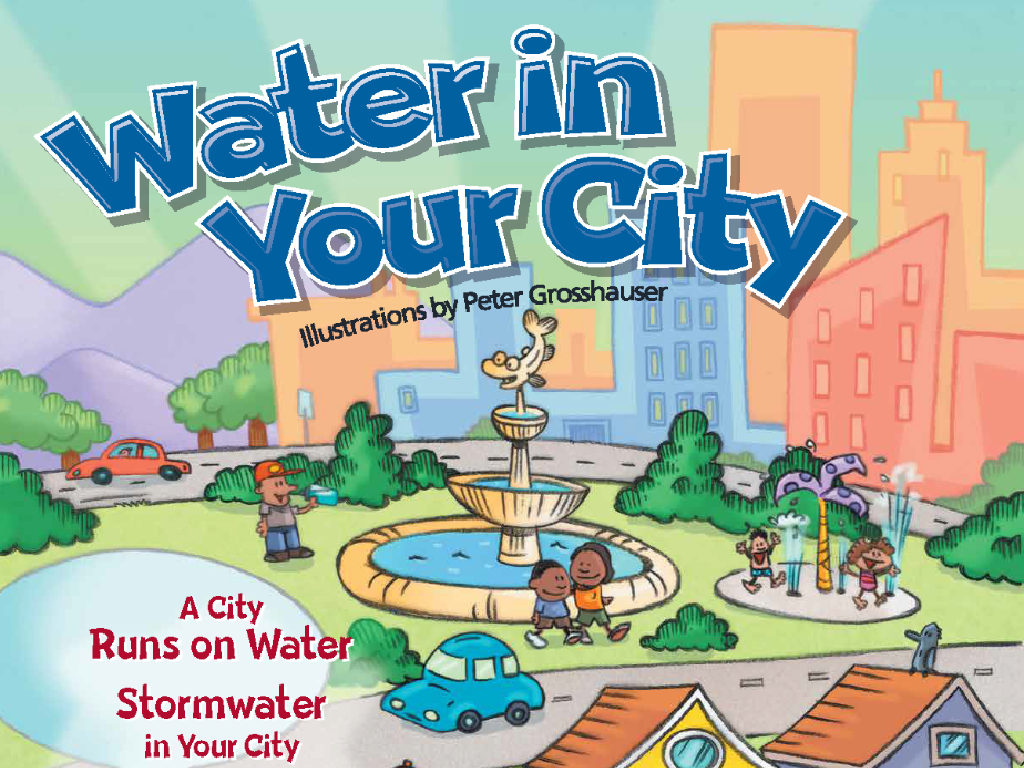Identify The Meaning Of Idioms And Adages: Set 1
Subject: Language arts
Grade: Fourth grade
Topic: Idioms And Adages
Please LOG IN to download the presentation. Access is available to registered users only.
View More Content
Exploring Idioms and Adages
– Understanding idioms and adages
– Phrases with a meaning different from the literal words
– The purpose of idioms and adages
– To express ideas in a creative or catchy way
– Examples of idioms and adages
– ‘Piece of cake’ means something is easy, ‘Break a leg’ means good luck
– Practice with common phrases
– We’ll learn to figure out what they really mean!
|
This slide introduces students to the concept of idioms and adages, which are phrases that have a figurative meaning different from the literal interpretation of the words. Idioms and adages enrich language by allowing for expressive and imaginative communication. They are often used to convey complex ideas in a simple, memorable way. Provide examples like ‘Piece of cake’ to illustrate that idioms can make language fun and engaging. Encourage students to think of idioms or adages they have heard at home or in media. In the next class, we’ll practice identifying the meanings of these phrases and understanding their usage in different contexts.
Understanding Idioms
– Idioms: Not literal phrases
– Phrases where the whole meaning is different from the individual words, e.g., ‘Piece of cake’ doesn’t mean a slice of dessert.
– Meaning differs from words
– The actual meaning is often surprising or funny compared to the words used.
– Can’t guess by individual words
– Example: Raining cats and dogs
– This idiom means heavy rain, not pets falling from the sky!
|
This slide introduces students to the concept of idioms, which are phrases where the meaning isn’t related to the literal words used. Explain that idioms are a fun part of language where the actual meaning is different and often can’t be guessed by looking at the individual words. Use the example ‘It’s raining cats and dogs’ to illustrate how idioms convey a meaning (heavy rain) that is not connected to the literal words (cats and dogs). Encourage students to think about why such phrases might have come into use and how they add color to language. Ask them if they have heard any idioms before and to share them with the class.
Exploring Adages in Language
– Understanding adages
– Short sayings believed to be true
– Adages offer advice or truth
– They often suggest how to act or think
– Example: ‘The early bird catches the worm’
– Success comes to those who are proactive
– Adages in everyday life
|
Adages are an important part of our language and culture, encapsulating wisdom that has been passed down through generations. They are typically short, memorable, and impart a lesson or moral that is widely accepted as a universal truth. For example, ‘The early bird catches the worm’ is an adage suggesting that those who start early or are proactive are more likely to succeed. This slide aims to introduce students to the concept of adages, understand their purpose, and recognize how they are used to convey messages in a concise way. Encourage students to think of adages they have heard at home or in school and discuss the meanings behind them.
Idioms in Action: What Does ‘Break a Leg’ Mean?
– Explore the idiom ‘Break a leg’
– An idiom often used in the theater
– Guess the idiom’s meaning
– Does it mean to literally break a leg?
– Discuss different interpretations
– Share your ideas with the class
– Learn the correct meaning
– It actually means ‘Good luck!’
|
This slide is designed to engage students in understanding idioms, specifically ‘Break a leg.’ Start by explaining that idioms are phrases with meanings different from the literal words. Encourage students to guess what ‘Break a leg’ might mean and discuss the various interpretations they come up with. Clarify that it’s a way to wish someone good luck, especially performers before they go on stage. Emphasize that idioms are a fun part of language and often reflect cultural practices or beliefs. Have students share their thoughts and then reveal the true meaning, fostering a lively and interactive learning environment.
Adages in Our Lives
– Adages in literature and speech
– Found in stories, talks, and daily talk
– ‘Don’t count your chickens…’
– Means don’t plan on things that haven’t happened
– Understanding the adage
– When to use this adage?
– Think of a time when you expected something that didn’t happen yet
|
This slide introduces students to the concept of adages and their prevalence in various aspects of communication. The adage ‘Don’t count your chickens before they hatch’ is used as a specific example to illustrate the idea that one should not assume the outcome of a situation before it happens. Encourage students to think critically about the meaning of this adage and to come up with personal or hypothetical situations where this wisdom might apply, such as expecting a good grade on a test without waiting for the result or planning how to spend money before actually having it. This will help them understand the practical application of adages in everyday life and improve their interpretive skills.
Idioms and Adages Around Us
– Idioms and adages in media
– Common in movies, TV, and ads
– They add color to language
– Find idioms in books/shows
– Look for sayings that aren’t literal
– Share your favorite examples
– Bring an example to discuss
|
This slide aims to introduce students to the prevalence of idioms and adages in everyday media. Explain that idioms and adages are phrases that have a meaning different from the literal words, making our language more vibrant and interesting. Encourage students to actively search for these expressions in their favorite books or TV shows, which will help them understand the context in which these phrases are used. Prepare to have a discussion in the next class where students can share the idioms or adages they found, and the class can guess the meanings together. This activity will enhance their comprehension skills and make them more aware of the nuances of language.
Practice Time: Idioms and Adages
– Understanding idioms and adages
– Idioms and adages are phrases with meanings different from the actual words.
– Group practice with examples
– We’ll look at phrases like ‘Piece of cake’ and figure out what they really mean together.
– Individual practice activity
– Find idioms in your book and guess their meanings.
– Share and discuss answers
– We’ll talk about the idioms you found and what you think they mean.
|
This slide is designed to engage students in the practice of identifying idioms and adages. Begin by explaining that idioms and adages are phrases where the words together have a different meaning than the words by themselves. Use common examples to illustrate this concept. Then, as a group, work through a few examples, discussing and defining each one. Afterward, give students time to work individually, finding idioms or adages in provided materials and writing down what they think these phrases mean. Conclude with a discussion where students share their findings and understandings, providing guidance and correct interpretations as needed. This activity will help solidify their grasp of idiomatic and proverbial language.
Class Activity: Idiom and Adage Charades
– Engage in charades with idioms/adages
– Act out phrases silently
– Use body language to convey the meaning
– Classmates guess the idiom or adage
– Think about how to represent the words through actions
– Have fun while learning
|
This activity is designed to help students understand idioms and adages through a fun and interactive game of charades. Before starting, explain to the students what idioms and adages are, using examples they might be familiar with. Divide the class into small groups and give each group a set of idioms and adages on slips of paper. Students will take turns acting out a phrase without speaking or making any vocal sounds, while their classmates try to guess the phrase. This will encourage students to think creatively about how to communicate the meaning of these phrases through actions alone. Possible idioms and adages for the activity could include ‘A penny for your thoughts’, ‘Spill the beans’, ‘The early bird catches the worm’, and ‘Don’t cry over spilled milk’.
Wrapping Up Idioms and Adages
– Congrats on learning idioms & adages!
– Homework: Find 2 idioms or adages
– Look in books, TV, or ask family members
– Write down their meanings
– What do they really mean? Write it in your own words
– Share your findings tomorrow
|
Students have been introduced to idioms and adages, phrases that have meanings different from their literal interpretation. For homework, they are tasked to find two idioms or adages from any source available to them, such as books, television shows, or family members, and write down what they believe these phrases mean. Encourage them to express the meanings in their own words to demonstrate understanding. In the next class, be prepared to facilitate a discussion where students can share their findings and explain the context in which they found their idioms or adages. This will help reinforce their learning and allow them to learn from each other’s discoveries.






